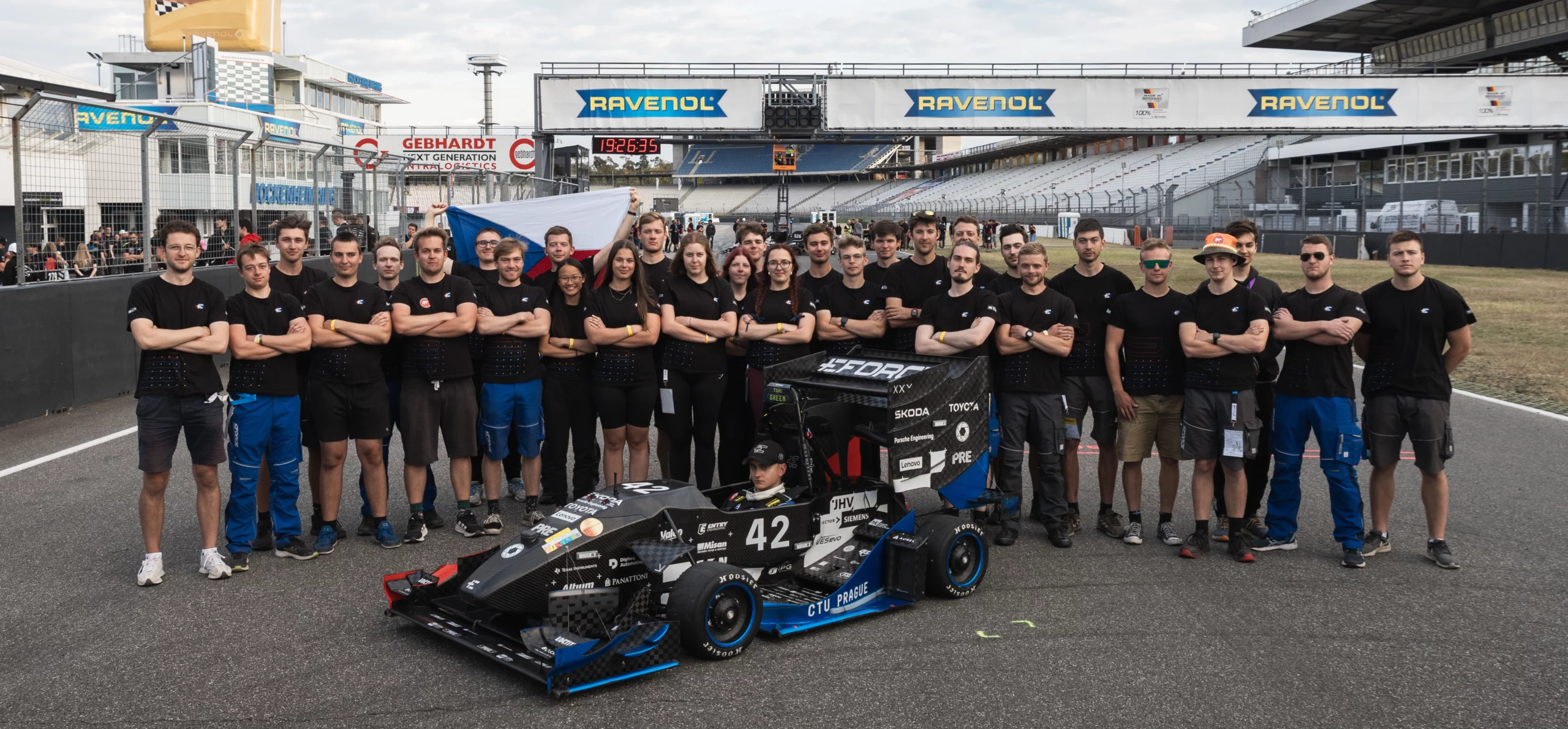Formula Student
Formula Student is an international competition for students of technical universities. Its main goal is to provide young engineers with an opportunity to gain valuable practical skills and experience not only in their field of study. Each season, teams design and build new single-seater race cars to compete against over 800 teams from around the world. Since 2010, the competition has also included purely electric vehicles, and since 2017, autonomously driven race cars as well.

OUR SEASON
Our season lasts one year, starting roughly in September and ending in August. We begin developing a new single-seater immediately after the last race is over. At the start of the season, if the weather allows, we use the previous year’s car for testing and verifying solutions that we could potentially use in the new concept. Simultaneously, we spend long hours modeling and designing the next-generation race car. The individual groups work on their respective parts, but they must all be coordinated to ensure the final car functions as a whole. The development phase concludes around the turn of the year with a “design freeze,” which is the final lockdown of the car’s concept for the season.

We then smoothly transition into the manufacturing phase, where work begins on the real parts. These are progressively machined, soldered, laminated, and otherwise processed. The most demanding part to manufacture is the monocoque, the composite body of the car, which takes approximately four months to produce, from preparing the molds to final curing. The manufacturing period culminates in a ceremonial event called the Rollout, where we present the new single-seater to the school, our partners, and the team’s supporters. Following this, we have weeks of testing and tuning to prepare us for the races themselves.
RACES
Formula Student races are now held across Europe and beyond. A standard race event lasts one week, and a team typically participates in three to four events per season. A total of 1000 points are available, distributed among various disciplines. The competition is divided into two categories: electric vehicles (EV) and autonomous vehicles (DV).

Every race week begins with technical scrutineering. Because the competition places a strong emphasis on safety, each car must pass a series of inspections that verify its readiness and compliance with the rules. For each successful inspection, the car receives a sticker that is put directly on the monocoque, indicating its readiness to drive. Scrutineering includes battery inspection, mechanical inspection, an electrical inspection divided into low-voltage and high-voltage parts, a driverless inspection for autonomous cars, a tilt test, a rain test, and finally, two brake tests—manual and EBS. The manual test verifies the driver’s ability to lock all four wheels, while the EBS test checks the functionality of the emergency brake system, which allows the autonomous car to be stopped remotely.
Dynamic disciplines
After successfully completing all the inspections, the dynamic disciplines, all of which are timed, take place.
For piloted cars, the first event is Acceleration, a 75-meter sprint that tests the car’s ability to get up to speed quickly. This is followed by Skidpad, where cars drive on a figure-eight-shaped track to test how well they handle sideways forces. Next is Autocross, a one-kilometer race with turns, chicanes, and straightaways. The times from Autocross are important because they also determine the starting order for the longest race, Endurance, which covers 22 kilometers and includes a mandatory driver change halfway through. The final discipline is Efficiency, which evaluates how well the car uses its battery energy relative to its race time. A key part of this is regeneration, or the ability to reuse energy gained from braking.
50 points
50 points
100 points
250 points
75 points
Akcelerace
50 bodů
Skidpad
50 bodů
Autocross
100 bodů
Endurance
250 bodů
Efficiency
75 bodů
DV Akcelerace
75 bodů
Autonomous cars compete in the same Acceleration, Skidpad, and Autocross events as the piloted cars. However, instead of Endurance, they compete in a discipline called Trackdrive, which consists of ten laps, each about one kilometer long. To navigate the track on its own, the driverless car follows a specific color code: orange cones mark the start and finish, blue cones are on the left side of the track, and yellow cones are on the right.
75 points
75 points
100 points
200 points
DV Skidpad
75 bodů
DV Autocross
100 bodů
Trackdrive
200 bodů
Static disciplines
Static disciplines focus on the engineering and business aspects of the project. In the Engineering Design discipline, the team presents their car concept to a panel of industry experts. These experts evaluate not only the specific technical solutions the team has used, but also their entire approach to the development process.
The Cost and Manufacturing discipline requires the team to create a Bill of Materials document, which lists all the car’s parts along with their manufacturing processes and costs. As of the 2025 season, the carbon footprint of the car’s production is also taken into account.
The final discipline is the Business Plan, where the team proposes a hypothetical product based on their race car. They must emphasize its commercial potential by creating an investment plan, a marketing strategy, and a logistical plan, among all the other details needed to make it a reality.
150 points
100 points
75 points

